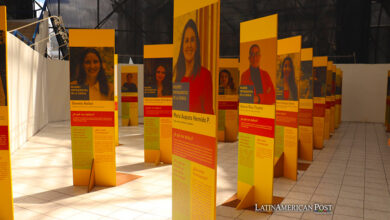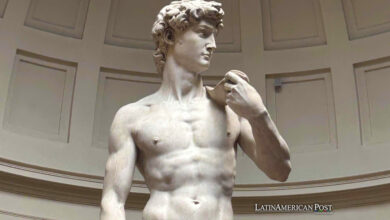Exhibition Cycle of Latin American Women Artists at the MAMBO 2021-II
You will be amazed by the creativity of Voluspa Jarpa, Luz Lizarazo, and Alba Triana at The Museum of Modern Art of Bogota. Their oeuvre will be exhibited at the museum until February 6, 2022.

The Woman Post | Diana Sedano Valdes
Escucha este artículo
Gender inequalities in art and museums have been highlighted in recent years, but the underrepresentation of women in the art world is still a problem. There are improvements in awareness; museums recognize the need to promote women's work and the importance of gender balance in art spaces. In fact, women-only and women-themed art exhibitions have been instituted to respond to gender imbalances. However, there is still a long way to go for museums to increase the number of women artists represented in their permanent collections. Nonetheless, museum art cycles dedicated to showing works by women should not seem like small steps; their impact should be acknowledged.
A Conversation to the South
The Museum of Modern Art of Bogota (MAMBO) opened its doors to host the cycle of excellence of Latin American women artists: Conversation to the South. It is a tribute to Marta Traba, founder of the MAMBO in 1962, who focused her career on Latin American art studies. The opening ceremony highlighted the importance of women's participation in art and cultural spaces. The panelists commented on the turn towards her story (written from a feminist perspective) instead of history (a predominant patriarchal narrative of evolution and all fields of knowledge and experiences). They emphasized women as diverse agents of change and how we must avoid a monolithic interpretation by advocating for an intersectional perspective.
Within the MAMBO collections, only 20% of the 1200 artists are women. In this sense, temporary art cycles dedicated to showcasing women's work should contribute to shifting towards permanent participation in the collections.
Alba Triana and Luz Lizarazo, from Colombia, and Voluspa Jarpa, from Chile, are currently the main artists at the MAMBO. Jarpa won the Julius Baer Prize for Latin American artists in its first edition, and Triana and Lizarazo's work was recognized for having some of the best pieces of art from Latin American artists. Their oeuvre will be exhibited at the museum until February 6, 2021. What can we experience at the MAMBO? #MujeresArtistasEnElMAMBO
Estados Vibracionales (Vibrational States) by Alba Triana
Alba Triana is a brilliant artist who has focused her career on music composition and its application in different forms of art, which are difficult to categorize in predetermined art branches. In this exhibition, she aims to show the fundamentals of life intersecting art, science, and technology. Her art piece Armonic Movement materializes sound through lights. You will be able to see vibrations and not just feel them or hear them. You will also experience how electromagnetism works, creating infinite sequences with suspended pendulums in her artwork Orbits. Moreover, you will see how massive groups interact (ex: fish, birds, or humans) in Entropic Ballet. Thus, Triana seeks to explore the essence of the matter. She considers art not only as a form of expression but also as a form of knowledge. She is an experimental artist who integrates meditation and interactions within her oeuvre.
She affirms that women are demanded a certain type of artwork or to be exotic and that is why her greatest revolution is to break with the established categories. She manifests to have a conflict with the limits because the natural world is diverse. Therefore, she does not consider isolating disciplines. She is convinced that in the act of erasing boundaries there is a political point. She also shows how women do not study composition and how being a director in a musical space is for men, just as it is for physics and technology.
Also read: VISUAL ARTISTS WHO HISTORICALLY SURPASSED SOCIAL PARADIGMS
Cicatrices (Scars) by Luz Lizarazo
Luz Lizarazo is presenting her first institutional exhibition that cumulates 15 years of works. Through her exhibition Scars, Luz Lizarazo highlights the essence and experiences of women. She addresses intimacy and how women are exposed to judgments, acts of violence, stereotypes, and sexuality. She explores households’ determinants for women. She delves into women as political and poetic territories. She addresses freedom and autonomy, but also coercion and fears, and aims to describe an unequal society between what’s feminine and masculine. Through visual plastic art, she denounces the systematic subjugation of the female voice and body. She works with human hair, wool, bones, wood, clay, and glass. She studies the domestic sphere in 5 different sections that include the pieces: The Girls, The Feminization of the Myth, Universe, Wunderkammer (Chamber of wonders), and Skin.
Lizarazo questions gender power relationships and talks about the feminine from home. She also expresses the difficulty of being an artist and being a mother at the same time, as well as the challenges of being a Latin American artist in international spaces.
Sindemia (Syndemic) by Voluspa Jarpa
Voluspa Jarpa is one of the most recognized Chilean artists. As Syndemic means two or more sequential pandemics which increase the prognosis and burden of disease; her oeuvre is a metaphor for the events in the Estallido Social Chileno (violent social riots during 2019 and 2020). She collected evidence from women fighting in the frontline, Mapuche poets, astrophysicists, and mathematicians to study how resistance, protests, and rebellions act against torture, sexual violence, and other Human Rights violations. Her work extends also to an analysis of violence in Colombia denouncing police violence and injustices. Through the study of the nature of archives, memory, and the cultural and symbolic notions of social drama, Jarpa shows photos, sculptures, wallpapers, maps, videos, among others, to denounce impunity as well.
She addresses hidden narratives (which include gender gaps) and reflects through art what happens in our violent society. Jarpa highlights that it is important that women dispute the narration of history and not only bear witness to it through resistance and the construction of memory. She prefers to speak of hysteria instead of history and conceives art as a mode of consciousness. She believes in the emancipation of women: We cannot be told when it is time to create.




